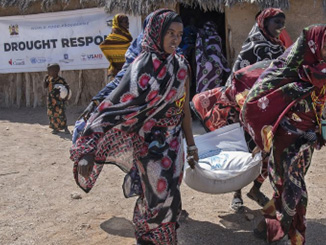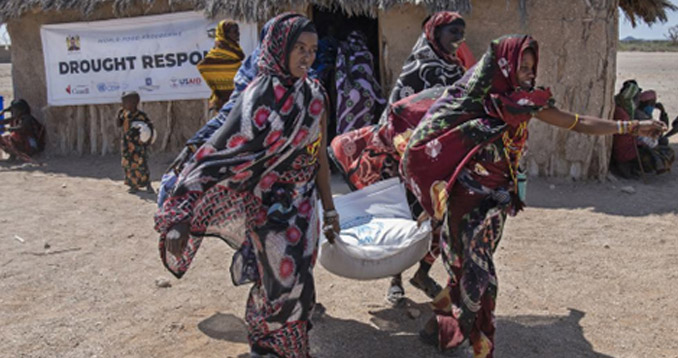

UN News Millions of people in the Horn of Africa – a region at the intersection of some of the worst impacts of climate change, recurring humanitarian crises and insecurity – are facing the driest conditions in four decades along with extreme food shortages. The top UN World Food Programme (WFP) official in the region, Michael Dunford, is warning that the situation there is likely to get worse before it improves.
In an interview with UN News, Mr. Dunford said: “Unfortunately, we have not yet seen the worst of this crisis. If you think 2022 is bad, beware of what is coming in 2023. What that means, is that we need to continue to engage. We cannot give up on the needs of the population in the Horn.”
Tweet URL
He warned that famine is still a threat, and while WFP was watching the situation closely, “we may see before the end of this year, or perhaps early next, a declaration of pockets of famine in parts of Somalia. What scares me most is that until we have serious rains, the drought will continue, and we could see a situation [of possible famine] replicated in some of the neighboring countries as well.”
Yet, despite this bleak outlook, Mr. Dunford praised the resilience of communities in the “very dynamic” region, as well as innovative ideas coming from WFP, other UN agencies, and donors, to help improve access to financing and new advances in agriculture. He believed that investing in the communities themselves was also critical, including, among others, in areas such as nutrition and girls’ education.
“We are looking for African solutions to the challenges, and WFP is both the catalyst and [conduit] to enable local economies and the agricultural sector [to] use those resources to meet the immediate needs in the region,” he said, and beyond that: “We’re already starting to think, how do we build resilience? How do we help these populations adapt to…a climate has changed? How can [they] adapt to their new circumstances and what can WFP and other partners do to support these new livelihoods?”
This interview has been edited for clarity and brevity.
UN News: We are doing this interview at a time where millions of people in the Horn of Africa are facing food insecurity because of drought. Can you paint us a picture on the situation?
Michael Dunford: Thanks very much for the question. And in fact, the situation in the region of Eastern Africa, particularly The Horn of Africa, has never been so bad. This time last year, there were 51 million people hungry, [or] acutely hungry. Today that figure stands at 82 million. So, we’ve seen a dramatic increase, almost 60 per cent over the course of just 12 months. And what’s driving it is conflict, climate, the effects of [the COVID-19 pandemic] and now this dramatic increase in costs. People are on the brink. We have situations in Somalia, Ethiopia, northern Kenya, and South Sudan where it’s the UN World Food Program (WFP) and others that are the difference between life and death. And the situation, unfortunately, is going to get worse before it improves.
UN News: For people who have never been there, just hearing this or watching reports about it on TV, can you tell them what women and children have to go through if they want to survive? You said it’s the choice between life and death. What do they have to do if they want one meal a day?
Mr. Dunford: So currently The Horn is experiencing the worst drought in over 40 years. Until recently, there were four failed rainy seasons. The current rains are also failing, so that’s creating huge displacement of populations, loss of livestock; people simply unable to meet their requirements. So, people are moving, people are on the move. There’s over a million internal displaced peoples (IDPs) created through the drought itself, and they are coming into centers where humanitarian actors, WFP and others, are able to provide essential lifesaving support. In the WFP’s case, we’re providing in Somalia cash transfers to over 4.7 million people. And in addition, we’re running nutrition programmes and supporting the broader humanitarian scale-up to ensure they have the logistics capacity and the telecommunications capacity necessary to be able to meet the needs of the population.
UN News: So, is famine still a threat in the region?
Mr. Dunford: Unfortunately, it is. The analysis continues, and we may see before the end of this year, or perhaps early next, a declaration of pockets of famine in parts of Somalia. What scares me most is that until such time that we have serious rains, the drought will continue. And we could see this situation replicated in some of the neighboring countries as well.
I met a woman recently when I was in Somalia. She’d walked for 28 days with seven children. When I talked to her, she had a child on her hip, clearly malnourished, and the woman herself, Amina, was registering so that she could access humanitarian assistance through WFP, and we were then referring her on to the nutrition centers so that she would be able to get the treatment necessary to ensure that her child survives. The situation is as bad as I have seen and of course it’s exacerbated by the conflicts and the insecurity, [which also] makes humanitarian access that much more difficult.
UN News: WFP had earlier requested $418 million to meet the urgent needs of crisis affected families through the rest of the year in the four drought-affected countries in the Horn of Africa. Is the amount still the same? And what has been the response so far?
Mr. Dunford: Fundraising for this operation, particularly at the front end when we knew this disaster was on the horizon, was challenging. We were competing with other operations and interests across the globe, the conflict in Ukraine being a very good example. By April we were able to raise the lion’s share of the funding that we needed, and we were able to go from 1.5 million beneficiaries to 4.7 million in Somalia alone. Across the region we’re now responding to the drought, supporting upwards of 9 to 10 million people. So, we have been able to scale up.
The key, however, is that we need to be able to sustain this operation, and hence, we will continue to require additional funding. Across the entire region, WFP needs $2.1 billion for the next six months. Huge numbers. Fortunately, the United States Government and others have come in substantially with much needed funding. But this now needs to be sustained until such time that the rains come, the drought is broken, and the population can return to where they came from.
UN News: Are there other options that you may use to reach out to donors because now you’re talking about the sustainability if funding is not forthcoming in the way that you had thought?
Mr. Dunford: So, we work closely with the IFIs, the international financial institutions – the World Bank, the African Development Bank, and others – and they are making funds available often through the host governments, so WFP can expand its operations accordingly. It’s also very important that we’re meeting the needs of the population today, the humanitarian needs. But we’re already starting to think, how do we build the resilience? How do we help these populations adapt to the changing climate? In fact, it’s not about changing climate: it’s the fact that the climate has changed. It’s unlikely we’re ever going to go back to where we’ve come. So, how can these populations adapt to their new circumstances and what can WFP and other partners do to support these new livelihoods?
UN News: You mentioned the resilience of the communities. Can you highlight any projects or strategic support that WFP, perhaps in collaboration with the other donors, may be carrying out in the region to ensure that some communities will be self-reliant instead of depending 100 per cent on humanitarian support? Are there any positive stories?
Mr. Dunford: There are lots of examples where WFP and others are investing in these populations, helping them better meet their future needs. We’re working with small holder farmers, introducing new farming techniques, addressing issues of postharvest loss. We’re working to enhance the education of the populations. We’re trying to ensure that young girls get the opportunity to go to school. We’re investing in nutrition: it’s much more important to address nutritional needs and prevent undernutrition than having to treat it. And then, of course, there’s large-scale resilience infrastructure programmes, giving access to waters, giving access to different types of technologies. We’re even investing in innovation, trying to introduce new innovative solutions, either originating from the region, which, as you know, is very rich and dynamic, or alternatively, offering ourselves as a conduit so innovations that come from abroad can be applied on the ground across the region.
UN News: What sorts of innovations? Could you give us some examples?
Mr. Dunford: Sure. So, it’s [things like] giving populations access to [tools to help them] better understand what the climate is going to be doing0, the weather forecasting. We’re giving them access to micro insurance products [and] we’re giving them an understanding of how better savings and loan programs can work. We’re looking to see how we can enhance or diversify agricultural practices, so they don’t all need to be [so] high tech. It’s more about introducing new approaches to populations who are eager to learn and benefit from the expertise that the World Food Programme and others have to offer.
UN News: And have the populations been responding positively to such innovations?
Mr. Dunford: Very positively. This is a very rich and dynamic region, particularly from [the perspective] of human capital. It’s about how can we, at the UN, support them [and] maximize the opportunities that exist.
UN News: So, in the same vein, the Black Sea Grain Initiative has contributed to the drop in commodity prices in Africa. Has there been a positive repose to that as well?
Mr. Dunford: Very positively. That is why it is essential that [the Initiative] continues, not only for the availability of commodities but also for the fertilizer. You know that region is a huge producer of fertilizer, much of which is destined to [other parts of] the region. A reduction in fertilizer costs translates into increase in yields for the farmers, and in turn an increase in food security. So, all these factors need to be to be considered by decision-makers. We certainly do not want to see a situation where that Initiative, after so much negotiation, is allowed to slip away.
UN News: There are reports from other countries, especially in Africa, that farmers have an excess supply of food that could be procured to avert famine in the Horn of Africa. Does WFP see any possibility of using that surplus as an option to bolster supplies?
Mr. Dunford: We are one of the biggest procurers of commodities across the region. In Eastern Africa last year, WFP in Eastern Africa bought over 744 thousand metric tonnes [and] spent $250 million procuring for our humanitarian operations. But the benefit is providing markets to farmers. We have recently done some analysis with University of California, Davis, we have quantified that every dollar WFP is spending on either procurement or logistics, is multiplying its value as it works towards the economy by 2.3 times. It is estimated that WFP is making a 1.42 per cent contribution to GDP across the region, and importantly, we are creating over 330,000 jobs to satisfy our needs to purchase locally and regionally and then direct those commodities back to our operations. This is one of the best stories I have to offer coming out of 2022 as to how WFP is having an impact on the economic development of the region.
UN News: In light of this, what is your message to governments in the region that are able to provide food that WFP can procure to avert famine in other areas?
Mr. Dunford: We are looking for African solutions to the challenges, and WFP is both the catalyst and [conduit] to enable local economies and the agricultural sector [to] use those resources to meet the immediate needs in the region.
UN News: What is your message to donors and residents of the Horn of Africa?
Mr. Dunford: Unfortunately, we have not yet seen the worst of this crisis. If you think 2022 is bad, beware of what is coming in 2023. This means that we need to continue to engage. We cannot give up on the needs of the population in the Horn. This is a population that has not contributed to climate change. They are not producers of greenhouse gases, but they are on the frontline experiencing the direct impact and shock [of climate change]. So, there is the issue of equity. All of us, irrespective of where we come from, need to address those needs.

Leave a Reply